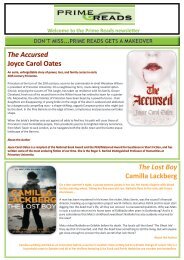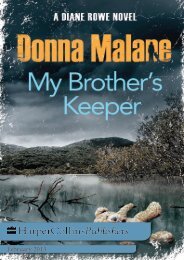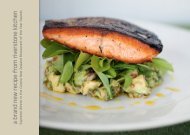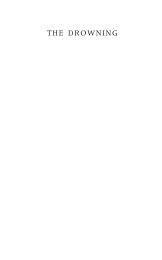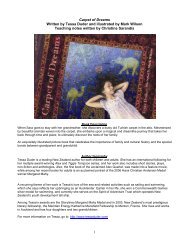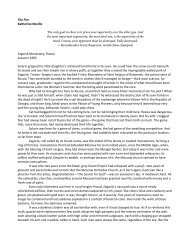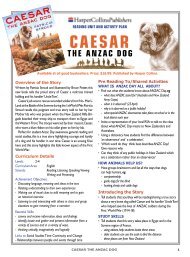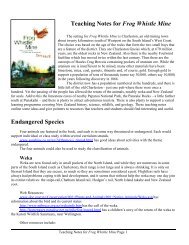Cry of the Taniwha - Harper Collins New Zealand
Cry of the Taniwha - Harper Collins New Zealand
Cry of the Taniwha - Harper Collins New Zealand
Create successful ePaper yourself
Turn your PDF publications into a flip-book with our unique Google optimized e-Paper software.
Teaching Notes for <strong>Cry</strong> <strong>of</strong> <strong>the</strong> <strong>Taniwha</strong> by Des Hunt<br />
<strong>Cry</strong> <strong>of</strong> <strong>the</strong> <strong>Taniwha</strong> is set in Rotorua, mostly on <strong>the</strong> outskirts <strong>of</strong> <strong>the</strong> Whakarewarewa<br />
<strong>the</strong>rmal area and nearby forest. There are links back to <strong>the</strong> devastating Tarawera<br />
eruption <strong>of</strong> 1886.<br />
The major <strong>the</strong>mes that background <strong>the</strong> story are:<br />
• <strong>the</strong>rmal activity<br />
• street gangs and gang culture<br />
• choices and <strong>the</strong>ir consequences<br />
• solving mysteries<br />
• racial interactions<br />
Thermal activity<br />
There are a number <strong>of</strong> websites that give information about <strong>the</strong> Whakarewarewa <strong>the</strong>rmal valley. However,<br />
easy-to-understand information about <strong>the</strong> underlying geology is difficult to find.<br />
• http://www.teara.govt.nz/EarthSeaAndSky/HotSpringsAndGeo<strong>the</strong>rmalEnergy/HotSpringsMudPoolsAnd<br />
Geysers/1/en is a good source <strong>of</strong> NZ information.<br />
• http://www.nps.gov/yell/naturescience/geo<strong>the</strong>rmal.htm has similar information based on<br />
Yellowstone National Park in <strong>the</strong> USA.<br />
The following publications cover three NZ geo<strong>the</strong>rmal fields:<br />
• Geology <strong>of</strong> Whakarewarewa Hot Springs by EF Lloyd (NZ Geological Survey, 1975) has good<br />
illustrations and simple explanations. It is available through <strong>the</strong> National Library Service.<br />
• Craters <strong>of</strong> <strong>the</strong> Moon Thermal Area by MA Mongillo (What’s <strong>the</strong> Story Publications, 2003) has<br />
useful information about hydro<strong>the</strong>rmal structures similar to those that are featured in <strong>Cry</strong> <strong>of</strong> <strong>the</strong><br />
<strong>Taniwha</strong>. The book is available through <strong>the</strong> National Library Service, or by writing to What’s <strong>the</strong> Story<br />
Publications, Postal Delivery Centre, Pirongia.<br />
• The Geo<strong>the</strong>rmal Guide to Wai-O-Tapu Thermal Wonderland by Bridget Y Lynne, is one <strong>of</strong> <strong>the</strong><br />
best <strong>the</strong>rmal area guides available. It can be obtained from Waiotapu Thermal Wonderland, PO Box<br />
1992, Rotorua 3040, email: waiotapu@geyserland.co.nz.<br />
Tarawera eruption<br />
The first two chapters <strong>of</strong> <strong>Cry</strong> <strong>of</strong> <strong>the</strong> <strong>Taniwha</strong> describe fictional events during <strong>the</strong> eruption, and <strong>the</strong>re are<br />
fur<strong>the</strong>r references throughout <strong>the</strong> story. These could lead on to an in-depth study <strong>of</strong> <strong>the</strong> disaster.<br />
Three very good websites covering <strong>the</strong> event are:<br />
• http://christchurchcitylibraries.com/Kids/NZDisasters/MtTarawera.asp<br />
• http://www.anheizen.com/<br />
• http://www.teara.govt.nz/EarthSeaAndSky/NaturalHazardsAndDisasters/HistoricVolcanicActivity/2/en<br />
Lesson plans and activities on volcanoes in general can be found from:<br />
http://www.enchantedlearning.com/subjects/volcano/activities.shtml<br />
http://edtech.kennesaw.edu/web/volcano.html<br />
Most school libraries will also have a book or two on <strong>the</strong> eruption. The National Library Service has a full<br />
collection.<br />
Teaching Notes for <strong>Cry</strong> <strong>of</strong> <strong>the</strong> <strong>Taniwha</strong> Page 1
Hydrogen sulphide<br />
The sulphurous smell <strong>of</strong> Rotorua is due to hydrogen sulphide gas H 2 S. Structurally this substance is very<br />
similar to water H 2 O, but has quite different properties. Around <strong>the</strong> home, hydrogen sulphide is most<br />
commonly produced by <strong>the</strong> decomposition <strong>of</strong> protein, ei<strong>the</strong>r in <strong>the</strong> human gut, by decomposing bacteria, or<br />
by cooking. If students want to investigate this, <strong>the</strong> safest way is through cooking egg protein.<br />
In a pot, cover a whole egg with cold water. Bring to <strong>the</strong> boil and simmer for at least 20 minutes. This<br />
long time is needed to ensure that <strong>the</strong> inside <strong>of</strong> <strong>the</strong> egg reaches at least 70 O C. Remove <strong>the</strong> pot from <strong>the</strong><br />
stove and let <strong>the</strong> egg and <strong>the</strong> water cool naturally.<br />
Remove <strong>the</strong> shell and open <strong>the</strong> white layer. The smell <strong>of</strong> hydrogen sulphide should be very obvious.<br />
Remove all <strong>the</strong> egg white and study <strong>the</strong> surface <strong>of</strong> <strong>the</strong> yolk. It should be covered with a khaki-coloured layer.<br />
This is iron sulphide, more correctly called ferrous sulphide. It is formed by <strong>the</strong> reaction <strong>of</strong> hydrogen sulphide<br />
and iron which occurs in all parts <strong>of</strong> <strong>the</strong> egg. Ferrous sulphide is reacted with acid in <strong>the</strong> laboratory<br />
production <strong>of</strong> hydrogen sulphide.<br />
If you want more hydrogen sulphide, <strong>the</strong>n put an uncooked egg in a hot-water cupboard for several<br />
weeks. Take it outside before opening it.<br />
Occultations and eclipses<br />
On 9 June 1886, <strong>the</strong> evening before <strong>the</strong> Tarawera eruption, <strong>the</strong>re was a unique astronomical event. Both <strong>the</strong><br />
planets Mars and Jupiter were occulted by <strong>the</strong> first quarter moon within hours <strong>of</strong> each o<strong>the</strong>r. The Mars’<br />
occultation was visible from Rotorua and features in <strong>the</strong> opening sequence <strong>of</strong> <strong>Cry</strong> <strong>of</strong> <strong>the</strong> <strong>Taniwha</strong>.<br />
An occultation occurs when one astronomical object blocks <strong>of</strong>f <strong>the</strong> light from ano<strong>the</strong>r. If it involves<br />
<strong>the</strong> sun, earth and moon system, it is more commonly called an eclipse.<br />
http://bonney.org/andrewchaikin/Occultation.html has three photographs showing <strong>the</strong> occultation<br />
<strong>of</strong> Mars by <strong>the</strong> moon.<br />
There are no occultations that will be visible from <strong>New</strong> <strong>Zealand</strong> within <strong>the</strong> next few years, but <strong>the</strong>re<br />
is one solar eclipse and many lunar eclipses.<br />
The lunar eclipses that are visible at a time suitable for children are:<br />
• 7 July 7 2009<br />
• 26 June 2010<br />
• 21 December 2010<br />
• 4 June 2012.<br />
The solar eclipse on 13 November 2012 will be an event <strong>of</strong> a lifetime for many children. While <strong>the</strong> total<br />
eclipse <strong>of</strong> <strong>the</strong> sun will not be visible from <strong>New</strong> <strong>Zealand</strong>, enough <strong>of</strong> <strong>the</strong> disc will be covered to cause<br />
considerable darkening. In Auckland, <strong>the</strong> amount covered will be close to 90%. Maximum coverage will be at<br />
10.28 NZ Daylight Savings Time.<br />
http://www.bbc.co.uk/science/space/solarsystem/sun/solareclipse.shtml has an excellent animation<br />
<strong>of</strong> a solar eclipse.<br />
An excellent free computer application for studying occultations and eclipses is Occult 4. It can be<br />
downloaded from: http://www.lunar-occultations.com/iota/occult4.htm.<br />
Teaching Notes for <strong>Cry</strong> <strong>of</strong> <strong>the</strong> <strong>Taniwha</strong> Page 2
Herons and o<strong>the</strong>r recent arrivals<br />
Two species <strong>of</strong> herons feature in <strong>Cry</strong> <strong>of</strong> <strong>the</strong> <strong>Taniwha</strong>. In <strong>the</strong> 1886 chapters, <strong>the</strong> heron is <strong>the</strong> white heron,<br />
kotuku. In <strong>the</strong> present-day chapters, <strong>the</strong> heron is <strong>the</strong> white-faced heron. This latter heron would not have<br />
been found around Rotorua in 1886 as it only began breeding in <strong>New</strong> <strong>Zealand</strong> in <strong>the</strong> 1940s. Since <strong>the</strong>n it has<br />
spread throughout <strong>the</strong> country and is now our most common heron.<br />
Most <strong>New</strong> <strong>Zealand</strong> birds had <strong>the</strong>ir origins in Australia. Some have been here so long that <strong>the</strong>y have<br />
evolved into different species. However, <strong>the</strong> more recent arrivals are identical to <strong>the</strong>ir Australian<br />
counterparts. Below is a list <strong>of</strong> birds that have settled in <strong>New</strong> <strong>Zealand</strong> since man arrived.<br />
• white-faced heron<br />
• royal spoonbill<br />
• grey teal<br />
• Australian coot<br />
• spur-winged plover<br />
• welcome swallow<br />
• silvereye or waxeye<br />
• pukeko<br />
• Nankeen night heron<br />
Through web and library research students should be able to find a date for <strong>the</strong> settlement <strong>of</strong> each <strong>of</strong> <strong>the</strong>se<br />
birds. From this <strong>the</strong>y can form a timeline showing when <strong>the</strong>y arrived. If some significant historical events are<br />
also placed on this timeline, it will give students <strong>the</strong> opportunity to visualize <strong>the</strong> scale <strong>of</strong> <strong>the</strong>se events.<br />
Students could also research <strong>the</strong> meaning <strong>of</strong> <strong>the</strong> following words to get a better appreciation <strong>of</strong> what<br />
constitutes a native bird.<br />
• indigenous species<br />
• endemic species<br />
• introduced species<br />
Metal detectors<br />
In <strong>Cry</strong> <strong>of</strong> <strong>the</strong> <strong>Taniwha</strong>, a metal detector allows <strong>the</strong> main characters to solve a mystery that goes back more<br />
than 130 years. The following activity gives <strong>the</strong> opportunity to investigate <strong>the</strong> operation <strong>of</strong> a metal detector,<br />
and (for <strong>the</strong> more technically minded) build an operating machine.<br />
Metal detectors use electromagnetic waves to detect <strong>the</strong> metal. Electromagnetic waves come in a<br />
range <strong>of</strong> frequencies from radio through microwave, infrared, light, ultraviolet, X-rays to cosmic rays. There<br />
are various types <strong>of</strong> metal detectors, but all utilize <strong>the</strong> alteration <strong>of</strong> a radio wave by <strong>the</strong> metal being<br />
detected. This alteration may be reflection or absorption and re-emission. The altered wave <strong>the</strong>n interferes<br />
with <strong>the</strong> original wave and, with a bit <strong>of</strong> electronics, can be turned into a sound or light signal.<br />
This effect can be demonstrated using an AM radio and simple calculator. The simpler <strong>the</strong>y are, <strong>the</strong><br />
better: <strong>the</strong> sort that can be purchased in gold-coin shops are ideal. The calculator is <strong>the</strong> transmitter <strong>of</strong> radio<br />
waves, and <strong>the</strong> AM radio is <strong>the</strong> receiver. When <strong>the</strong> two are put in close proximity, <strong>the</strong> sound <strong>of</strong> <strong>the</strong><br />
calculator is heard on <strong>the</strong> radio. If any metal is nearby <strong>the</strong>n <strong>the</strong> sound is altered.<br />
The instructions are available at: http://www.wikihow.com/Make-a-Homemade-Metal-Detector.<br />
Photos and video for <strong>the</strong> above can be seen at: http://www.instructables.com/id/HomeMade-Metal-<br />
Detector/HomeMade-Metal-Detector.pdf.<br />
Teaching Notes for <strong>Cry</strong> <strong>of</strong> <strong>the</strong> <strong>Taniwha</strong> Page 3
For those who want to go metal detecting, reasonably cheap models can be found by searching for<br />
‘metal detector’ at <strong>the</strong> following sites.<br />
• http://www.surplustronics.co.nz/shop/<br />
• http://www.zillion.co.nz/<br />
• http://www.outtoplay.co.nz/<br />
The electronically minded can make one out <strong>of</strong> components using <strong>the</strong> circuit at:<br />
http://www.talkingelectronics.com/html/MetalDetector.html<br />
<strong>Taniwha</strong><br />
Two excellent sources <strong>of</strong> information on taniwha are:<br />
• http://en.wikipedia.org/wiki/<strong>Taniwha</strong><br />
• http://www.teara.govt.nz/TheBush/UnderstandingTheNaturalWorld/<strong>Taniwha</strong>/en<br />
Land-based and inland-water taniwha <strong>of</strong>ten have <strong>the</strong> form <strong>of</strong> a reptile which might be based on tuatara or<br />
<strong>the</strong> giant gecko called kaweau. Also called kawekaweau, details <strong>of</strong> this gecko are sketchy as <strong>the</strong>re is only one<br />
specimen. Information is available at:<br />
• http://www.bio.ucalgary.ca/contact/faculty/pdf/russell/46.pdf<br />
• http://en.wikipedia.org/wiki/<strong>New</strong>_<strong>Zealand</strong>_giant_gecko<br />
• http://www.teara.govt.nz/TheBush/FishFrogsAndReptiles/NgararaReptiles/3/ENZ-<br />
Resources/Standard/1/en<br />
• http://nzcryptozoologist0.tripod.com/id17.html.<br />
A Friend in Paradise by Des Hunt is a children’s novel that features a living kaweau.<br />
Teaching Notes for <strong>Cry</strong> <strong>of</strong> <strong>the</strong> <strong>Taniwha</strong> Page 4




